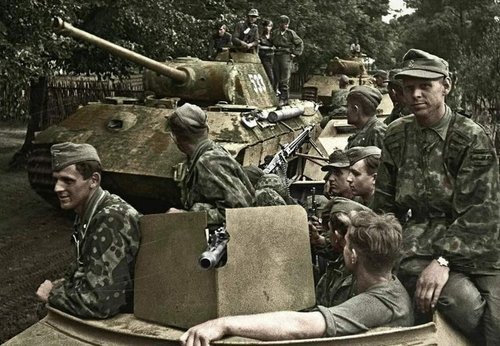RARE! WWII 1940 Blitzkrieg German Panzer Division “Invasion of France” France (Bordeaux Region) Double-Sided Combat Road Invasion Blitzkrieg Booklet Map


















RARE! WWII 1940 Blitzkrieg German Panzer Division “Invasion of France” France (Bordeaux Region) Double-Sided Combat Road Invasion Blitzkrieg Booklet Map
Comes with a hand-signed C.O.A.
*The Rise of the Panzer Division: Sustained mobility was the game-changer of 20th-century warfare, and it gave Adolf Hitler the confidence to wage the greatest war in human history.
This rare and museum-grade WWII German combat mini map is an original 1940 dated German Panzer Division “Invasion of France” combat road map preserved from a German invasion map booklet. This WWII German combat map comes from a larger collection of extremely rare WWII German Panzer Division artifacts.
This double-sided map comes from a small German-handled map booklet (dated 1940 and printed in Berlin) that would accompany larger German invasion maps. This mini-map page provided a more specific and detailed view of French roads in specific regions and towns in South-Western France.
This German combat booklet page was produced for the German blitzkrieg into the French region around Bordeaux where the 7th Panzer Division of the German Army was sent to Bordeaux after the armistice with France was signed on June 22, 1940.
The division was there to re-equip and prepare for Operation Sea Lion, the planned invasion of Britain. The 7th Panzer Division earned the nickname "Ghost Division" for its surprise attacks during the invasion of Belgium and France. A German Panzer Division consisted of a Panzer brigade and a motorized infantry brigade. The Panzer brigade had four battalions, each with 128 tanks. The division also had command tanks, bringing the total number of tanks to 561.
The Role of German Panzer Divisions: Invasion of France and Beyond
The Panzer divisions of Nazi Germany, known for their formidable combination of speed, coordination, and firepower, were central to the German military strategy during World War II. From their critical role in the Blitzkrieg across France in 1940 to their fierce resistance following the Allied invasion of Normandy in 1944, these armored units represented the backbone of Germany’s tactical operations in the Western Front. This essay examines the deployment, operational strategies, challenges, and eventual decline of the German Panzer divisions during these pivotal moments in the war.
Early Dominance: The 1940 Blitzkrieg in France
In May 1940, the Wehrmacht launched its offensive in Western Europe, marking a pivotal shift in military tactics. The German strategy, later termed Blitzkrieg or "lightning war," integrated the concentrated use of tanks, motorized infantry, and air power to break through enemy lines and encircle opposing forces swiftly. The Panzer divisions were at the forefront of this strategy.
The German Panzer divisions typically comprised a mix of tanks, motorized infantry, artillery, and support units. In 1940, a standard division included around 15,000 men and 150 to 200 tanks. The core of the Panzer division’s effectiveness lay in its ability to perform combined arms operations, where tanks, infantry, and artillery supported one another to achieve tactical and operational objectives rapidly.
During the invasion of France, the Germans fielded ten Panzer divisions, forming part of the larger Army Groups A and B. The most striking maneuvers were conducted by Army Group A, which pushed through the Ardennes, a region previously considered impassable for armored units. This unexpected move allowed the Panzers to bypass the strongest points of the French defenses, the Maginot Line, and advance deep into French territory.
The result was catastrophic for the Allies. The Panzers reached the English Channel in just ten days, splitting the Allied forces in half and isolating the British Expeditionary Force in the north from the French armies in the south. Towns and cities fell rapidly as German forces executed pincer movements, encirclements, and forced surrenders. By June 1940, France was forced to capitulate, marking a stunning success for the Panzer divisions and solidifying the effectiveness of the Blitzkrieg.
From Dominance to Defense: The Normandy Invasion and Subsequent Battles
The situation in 1944 was starkly different from that in 1940. By this time, the German military was stretched thin on multiple fronts, with significant resources diverted to the Eastern Front and Italy. The Panzer divisions in France, although still a formidable force, faced new challenges and limitations.
As the likelihood of an Allied invasion grew, German high command moved several Panzer divisions to France. However, strategic miscalculations and Hitler’s direct interference often hampered their effective deployment. When the Allies landed in Normandy on June 6, 1944, only a few Panzer divisions were immediately available to respond.
The Panzer divisions played a crucial role in Germany's defensive operations following D-Day. Notable among these were the 2nd SS Panzer Division "Das Reich" and the 12th SS Panzer Division "Hitlerjugend," both of which were engaged in intense combat around key locations such as Caen. Despite their efforts, the Panzer divisions struggled against overwhelming Allied air superiority and the logistical difficulties of reinforcement and resupply.
Decline and Overstretch
As the Battle of Normandy progressed, the Panzer divisions were increasingly worn down. Continuous Allied air attacks and a relentless offensive push strained German capabilities. The Falaise Pocket, a decisive engagement in August 1944, encapsulated this deterioration. Encircled by Allied forces, much of what remained of the German armored units in Normandy was destroyed or captured, significantly weakening the Panzer force.
The German Panzer divisions, emblematic of the Wehrmacht’s military prowess, showcased both the strengths and vulnerabilities of Blitzkrieg tactics. Their early successes in France in 1940 demonstrated the effectiveness of rapid, armored warfare. However, the sustained attritional warfare following the Normandy invasion exposed the limitations of the Panzer divisions, particularly when faced with superior air power and logistical challenges. The evolution from offensive spearheads to beleaguered defenders highlights the adaptability but also the eventual exhaustion of these key units in the face of shifting strategic realities of World War II.